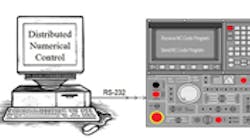No machine shop is perfect. However, a significant number of manufacturing facilities believe that their manufacturing processes are as efficient as they need to be. The mentality is that as long as a company sees productivity, then change is unnecessary.
Even when a technological advancement is sure to benefit a manufacturer, it is still difficult for them to use the resources it would take to implement such technology.
Fortunately, there are programs for helping manufacturers use and benefit from new processes and technologies. One such program is the Smart Machine Platform Initiative that involves an intelligent machining network.
The intelligent machining network connects different aspects of a manufacturing process through computer links. These, in turn, integrate functions that traditionally would have been separate. Such a connection can significantly improve areas in the process in which communication hinders machining operations and enable those areas to automatically and continuously improve themselves.
The ideal intelligent machining network allows for the efficient design, development and production of parts on a continuously improving basis.
Not only does this capability drive production, it also allows those involved in the process to easily communicate all necessary information for that process.
As many of these individual technologies can be a benefit for many manufacturers, TechSolve is moving forward with the integration and automation of these technologies through the use of a common interface. This automation does not have to eliminate the human element in manufacturing, but it can make people’s actions more efficient, accurate and many times less complicated.
The key to improving manufacturing process communication is first to pinpoint the areas of the process in which miscommunication is causing setbacks. Design, simulation, tooling/ fixturing, shop floor monitoring, and NC program storage and transference typically cause the most significant communication breakdowns.
Most manufacturers use some form of CAD/CAM to design and model parts, yet many shops don’t use CAD/CAM solutions to their full potential. For example, with the ability to input tool geometry into a 3D simulation environment, engineers can accurately use collision detection that can help to reduce scrap, prevent machine tool damage and improve worker safety. The path of the cutting tool also can be simulated with actual tool geometry.
That means that shops can revise tool dimensions easily because importing the tool geometry automatically can change the tooloffset parameters. For example, if a change to a milling process requires a different size mill, the tool path would update automatically based on the new information. Then, parameters would change in the program code, and the part could be manufactured without having to rewrite an NC code.
Disorganized tool cribs, often an overlooked problem area in machine shops, can debilitate a manufacturing process much more than most companies realize. Often, tool usage and inventory is not tracked systematically, so tools are not ordered at the right time or in the right quantities. That leads to wasted time and rework because of broken tools, shipping delays and unexpected downtime.
Tool-crib management, or tooldata management, is important even for shops that do not require frequent tool changes in their machining processes. No matter how often a tool change occurs, the time spent looking or waiting for a new tool is unscheduled downtime.
Several available software solutions allow shops to manage their tool data digitally, giving them access to complete digital tooling catalogs that, when incorporated with tool ordering, makes tracking and restocking tool inventory extremely simple. Some software even will communicate a scheduled purchase order to a supplier to order new tools automatically.
Some tool-data software packages interface with CAD/CAM packages to allow engineers to import tool geometry and feeds and speeds into a CAD/CAM environment. That boosts cutting condition data and, in turn, results in more reliable collision detection. Once all of this information is put into CAD/CAM, programmers can be more efficient in writing code — resulting in significant time savings.
Because of insufficient storage space for all of the code that goes to and from today’s machine tool controls, many shops use disks or even laptops to store machine code.
So to change or update code on a given machine, an engineer or programmer must walk to the control, causing downtime. With no hierarchy or structure to organize the NC code, a lot of time also can be spent on looking for code that was used in the past. That ultimately can require that new code be generated from scratch.
Distributed numerical control (DNC) is a solution for organizing and transferring NC code to machine controls. Various software applications within the DNC can store information, and the NC code then can be organized by machine, part, material or process, or however the user prefers.
Several machines can use the same DNC data if the data is stored at a central location, such as at a public server.
If the server is open, DNC data can be transferred through on a specified folder, and machine operators can pull the information from the folder and send it to the control. Shops can save considerable amounts of process lead time when machine operators have easy access to programs and get information directly from the programming source.
Scheduling and monitoring an entire facility is another challenge that manufacturers face, especially those that machine in 24-hr shifts or are doing lights-out operations.
In-process monitoring of machines and personnel can help management pinpoint trouble areas before they cause major delays in manufacturing. By linking machine tools and monitoring production through a digital interface, management can observe the jobs, parts and machines that are in production.
Data put out from machines also provides access to charts, graphs, and other analyzing tools because that data can be collected in real time through engineering data-management software. That information from machines is automatically and chronologically stored in a database, and can be used to identify areas within a process that need improvement.








